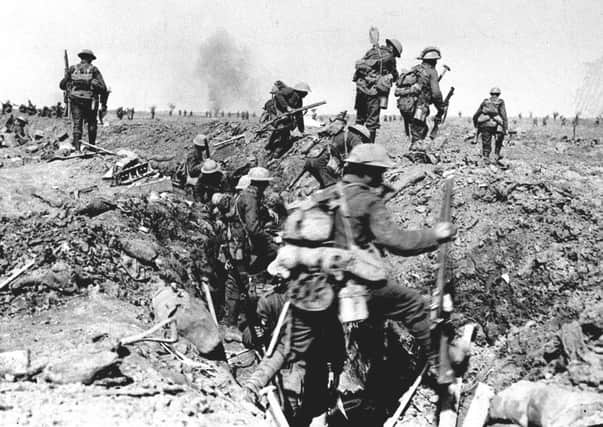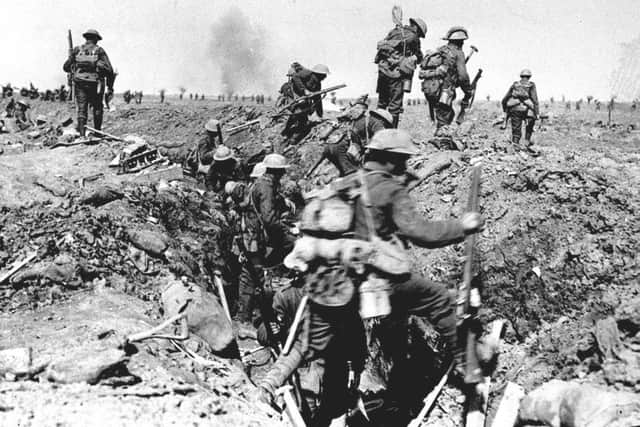Behind the Battle of The Somme


And today sees the UK come together once again to mark the sacrifices of those killed in the Battle of the Somme 100 years ago.
At 7.30am, on July 1, 1916, thousands of British soldiers clambered out of their muddy trenches to assault dug-in German positions.
Advertisement
Hide AdAdvertisement
Hide AdBy the end of the four-month battle in northern France, more than a million soldiers had been killed and wounded on both sides of the fighting.


But the true fight started months before the first shot was fired.
The Allies’ original plan was for an attack on three European fronts in a bid to end years of sapping trench warfare.
French and British commanders began discussions in late 1915 for a joint attack along a 25-mile front straddling the once-picturesque River Somme in Picardy in northern France.
Advertisement
Hide AdAdvertisement
Hide AdBut the German attack on French forces at Verdun in February 1916 meant the Allies had to alter their plan and bring more British soldiers into the attack.


As Nigel Steel, historian at the Imperial War Museum, explains: ‘The fighting at Verdun quickly drew in more and more French troops and it gradually became clear that the French army would be unable to sustain the defence of Verdun and lead an attack on the Somme.
‘The proposed frontage of France’s attack on the Somme was reduced from 25 to eight miles and, for the first time in the war, the main burden of the assault would be borne by the British.’
General Sir Douglas Haig, the British commander, ordered a week-long artillery bombardment of more than a million shells from the village of Serre to Maricourt that would allow troops to punch a huge hole in the German lines.
Advertisement
Hide AdAdvertisement
Hide AdThis would allow cavalry units to pour through and go east to Bapaume and north towards Arras, breaking the trench deadlock.
But things did not go to plan and left the British Army in tatters after the bloodiest day of fighting in its history.
The week-long artillery barrage had failed to do anywhere near as much damage to the well-made German defences as had been hoped.
And many of the attacking forces were ‘pals battalions’, volunteer units of friends and co-workers created the previous year in Lord Kitchener’s New Army and relatively unblooded.
Advertisement
Hide AdAdvertisement
Hide AdIn the French mud many of them would die together, leaving gaping holes in their local communities and in their families
Many were told to walk slowly across no-man’s land in a line because of their inexperience. They were slaughtered by deadly German machine gun fire.
The attacking divisions lost 19,240 men killed, with 57,470 casualties overall.
Mr Steel added: ‘It’s hard, when discussing the battle as a whole, not to be brought up short by this enormously traumatic event and to award it a disproportionate amount of attention.
Advertisement
Hide AdAdvertisement
Hide Ad‘It was there, on that day in particular, that the British attitude to war changed.
‘The scale of the losses destroyed any patriotic enthusiasm that still lingered from 1914.
‘There was now clearly going to be no triumphal march on Berlin. Instead, the war would be a long, slow grind paid out at great cost.’
The battle itself dragged on for four months, with an average British casualty rate of 3,000 a day as it sank into 141 days of attrition.
Advertisement
Hide AdAdvertisement
Hide AdAfter the opening assault, the next major set-piece attack was at the Battle of Flers-Courcelette in September, known as the debut of the tank in modern warfare.
The last major battle was at the Ancre in October. The Battle of the Somme officially ended on November 18. The net gain was a strip of land 20 miles wide and six miles deep. Despite the bloody toll for such little gain, the battle was not considered a total failure.
Even on the first day, the New Army units in the south of the Somme showed that they could fight, taking objectives from Fricourt to Montauban.
Also, a German officer famously described the battle as the ‘muddy grave of the German field army’ and they eventually left the trenches of the Somme in early 1917.
Advertisement
Hide AdAdvertisement
Hide AdMr Steel says: ‘The pressure of the Somme, exercised through attack and counter-attack, was keenly felt by the Germans.
‘Under new command from the end of August, they began to plan and prepare for a local withdrawal to new, scientifically constructed, inter-connecting lines of defence some distance back and known to the British as the Hindenburg Line.
‘When the Germans pulled back to these new positions in February and March 1917, the ground occupied by the BEF (British Expeditionary Force) and its French allies to the south represented as much a gain of the Battle of the Somme as that occupied over the 141 days of the battle itself.’
Today will see the Queen and other royals leading commemoration both in the UK and in France.
Advertisement
Hide AdAdvertisement
Hide AdLast night at Westminster Abbey saw the Queen and Duke of Edinburgh will join the congregation for an evening commemoration.
And in France the Duke and Duchess of Cambridge and Prince Harry will attend a vigil in memory of the fallen
A two-minute silence will be held nationwide to remember the sacrifices of all those who fought and lost their lives.
The Somme: a timeline that led to tragedy
1914:
June 28 - Archduke Franz Ferdinand, heir to the throne of the Austro-Hungarian Empire, is assassinated in Sarajevo, setting in train a chain of events which lead to a general European war.
Advertisement
Hide AdAdvertisement
Hide AdAugust 4 - Britain declares war after Germany invades neutral Belgium.
August 5 - Lord Kitchener becomes Secretary of State for War and launches mass recruitment campaign. A 100,000-strong British Expeditionary Force begins to cross the Channel.
August 28 - Lord Derby coins the phrase ‘Pals’ to describe new battalions of like-minded men at a meeting in Liverpool.
August 28-29 - Fighting on Somme during French retreat.
September 22-27 - Fighting near the town of Albert during the ‘race to the sea’ which defined what was to be the front line during the next 18 months of stalemate.
1915:
Advertisement
Hide AdAdvertisement
Hide AdFebruary 19 - British naval attack in the Dardanelles, Turkey, begins.
April 25 - Start of the Gallipoli campaign. Ottoman Empire was to lose 300,000 men and the Allies around 214,000 before troops were eventually evacuated in December 1915 and January 1916.
Late 1915 - General Sir Douglas Haig becomes commander-in-chief of British Expeditionary Force.
December - Allied conference at which an offensive on the Somme is agreed.
1916:
Advertisement
Hide AdAdvertisement
Hide AdFebruary 21 - German bombardment of the town of Verdun further along the line begins.
May 19 - German attack on Verdun forces French to divert troops from Somme.
May 31 - Battle of Jutland inflicts major damage on German navy which was to spend the rest of the war in its home ports giving British fleet effective control of seas and meaning imperial troops and supplies could reach Europe with much greater ease.
June 24 - Allied bombardment at the Somme begins.
June 29 - Heavy rain forces postponement of attack.
July 1 - Battle of the Somme begins. French troops advance, but British forces suffer almost 20,000 men dead in one day.
Advertisement
Hide AdAdvertisement
Hide AdJuly 14 - Renewed British assault along shorter front line. South African troops begin important attack on Delville Wood.
July 23 - British and Commonwealth attack on key Guillemont-Pozieres area begins. Australians finally capture Pozieres two days later.
September 3 - Renewed British attack in northern section of Somme battlefield.
September 15 - Tanks used in battle for first time in history.
Advertisement
Hide AdAdvertisement
Hide AdSeptember 26 - Joint Franco-British offensive. Thiepval finally taken.
October 7 - Rain delays further Allied advances, leading to a renewed war of attrition.
November 18 - End of Somme offensive.
1917:
March 16 - Germans withdraw from the Somme to the Hindenburg Line.
1918:
March 21 - Beginning of new German offensive which is to lead to renewed fighting on the Somme.
August 8 - Allied counter-offensive, later referred to as the “Black day of the German Army”.
November 11 - Armistice.